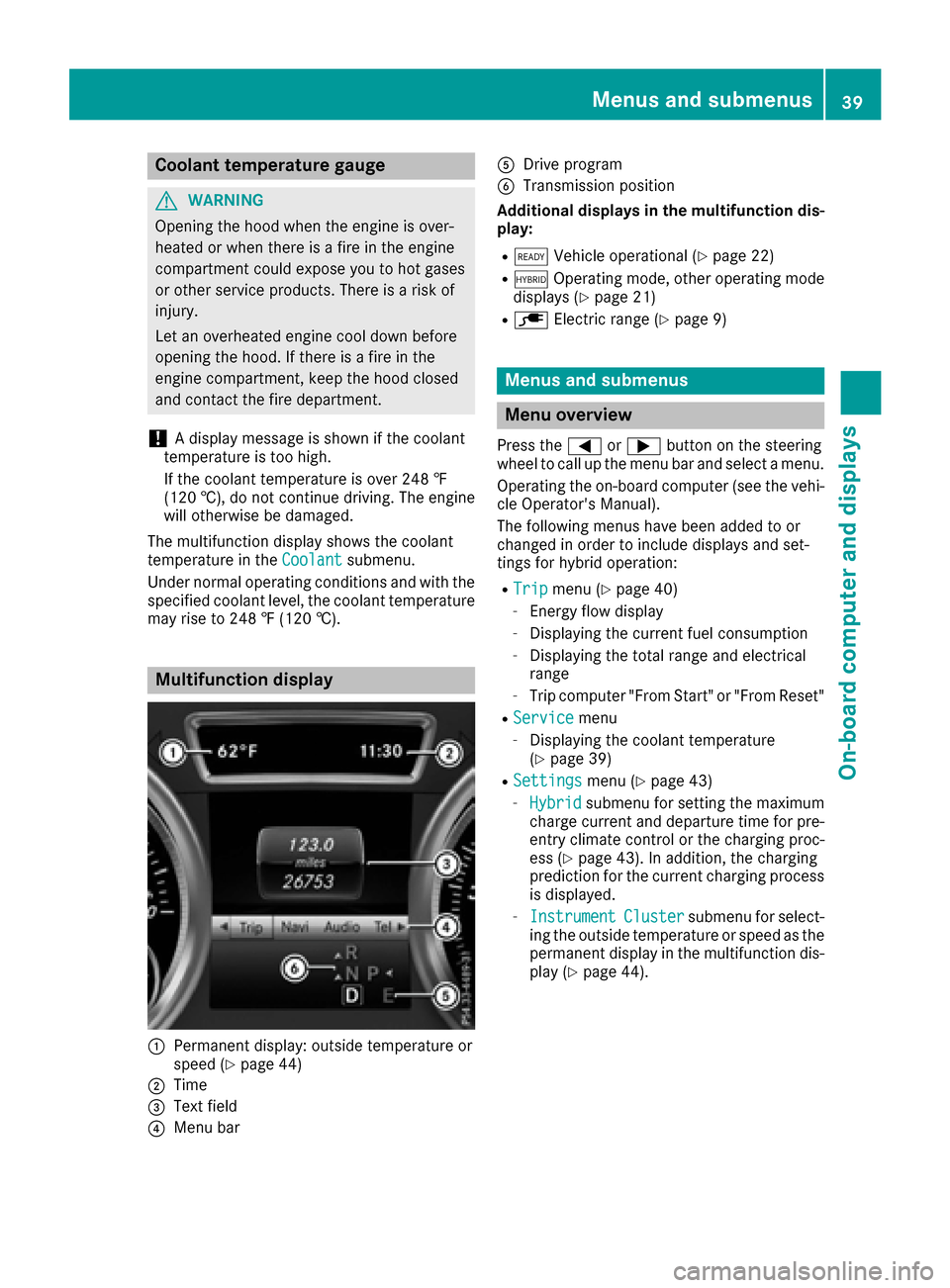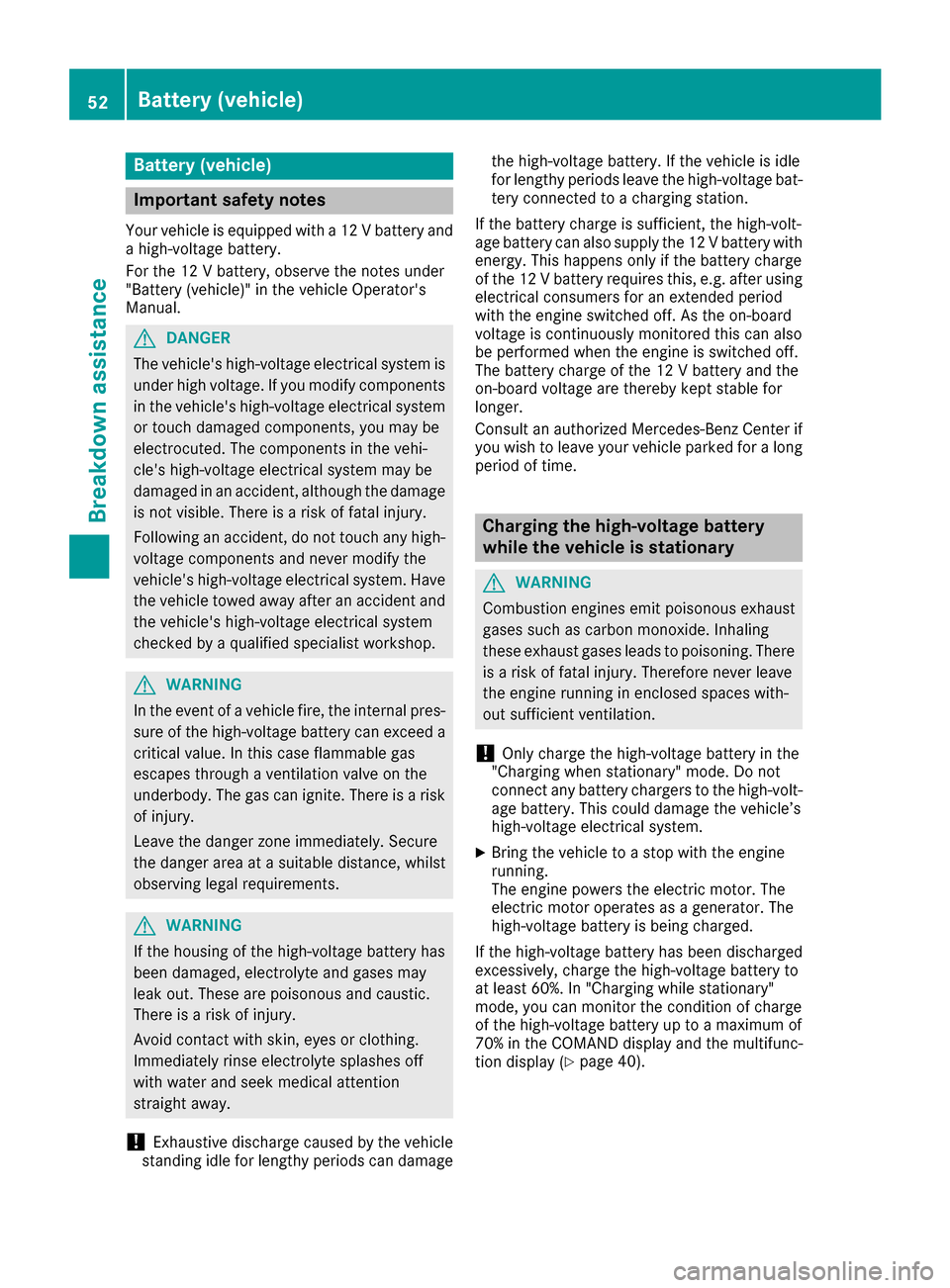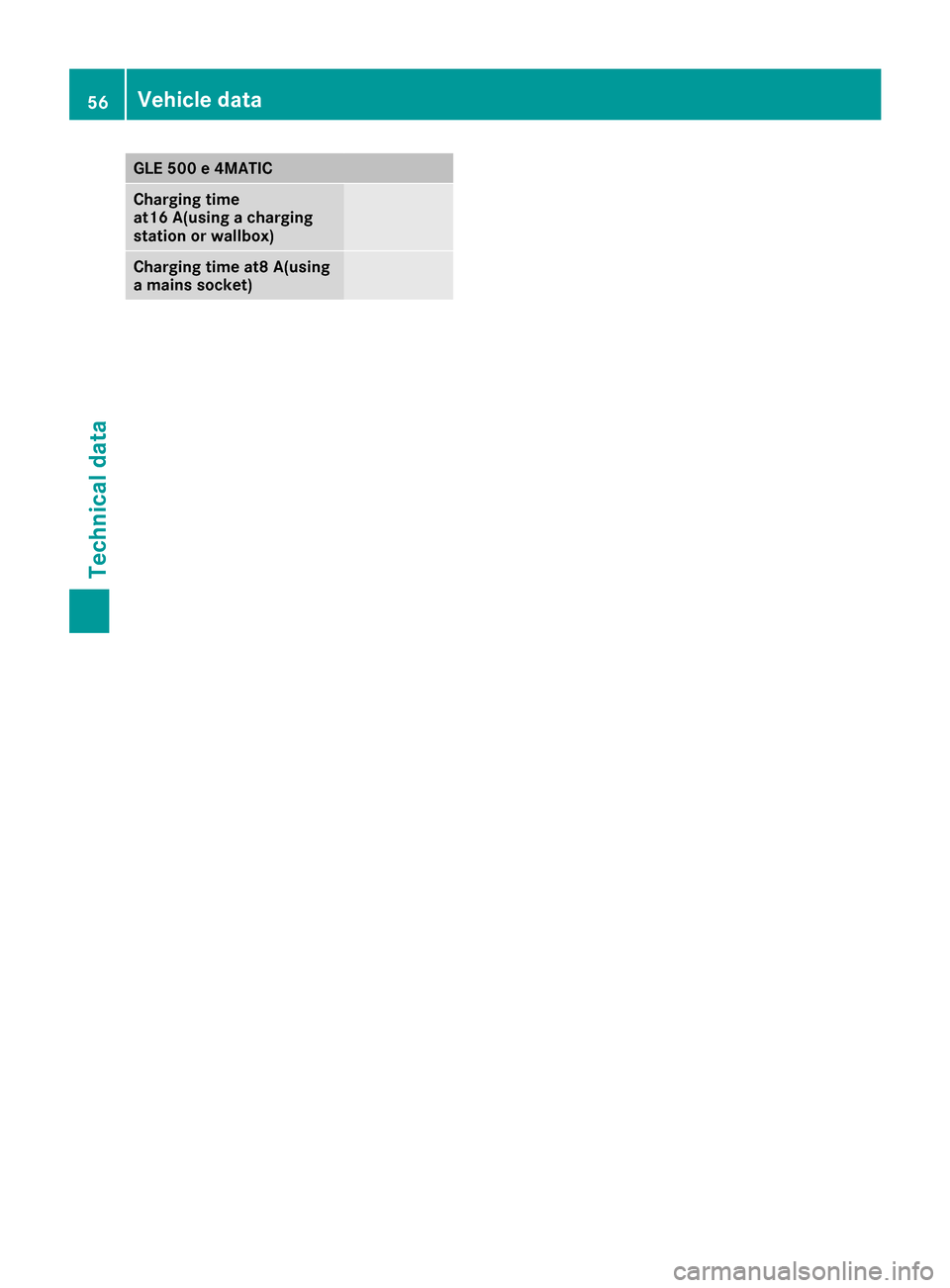2017 MERCEDES-BENZ GLE SUV HYBRID charging
[x] Cancel search: chargingPage 41 of 58

Coolant temperature gauge
GWARNING
Opening the hood when the engine is over-
heated or when there is a fire in the engine
compartment could expose you to hot gases
or other service products. There is a risk of
injury.
Let an overheated engine cool down before
opening the hood. If there is a fire in the
engine compartment, keep the hood closed
and contact the fire department.
!A display message is shown if the coolant
temperature is too high.
If the coolant temperature is over 248 ‡
(120 †), do not continue driving. The engine
will otherwise be damaged.
The multifunction display shows the coolant
temperature in the Coolant
submenu.
Under normal operating conditions and with the
specified coolant level, the coolant temperature
may rise to 248 ‡ (120 †).
Multifunction display
:Permanent display: outside temperature or
speed (Ypage 44)
;Time
=Text field
?Menu bar
ADrive program
BTransmission position
Additional displays in the multifunction dis-
play:
Rõ Vehicle operational (Ypage 22)
RñOperating mode, other operating mode
displays (Ypage 21)
Rè Electric range (Ypage 9)
Menus and submenus
Menu overview
Press the =or; button on the steering
wheel to call up the menu bar and select a menu.
Operating the on-board computer (see the vehi- cle Operator's Manual).
The following menus have been added to or
changed in order to include displays and set-
tings for hybrid operation:
RTripmenu (Ypage 40)
-Energy flow display
-Displaying the current fuel consumption
-Displaying the total range and electrical
range
-Trip computer "From Start" or "From Reset"
RServicemenu
-Displaying the coolant temperature
(Ypage 39)
RSettingsmenu (Ypage 43)
-Hybridsubmenu for setting the maximum
charge current and departure time for pre-
entry climate control or the charging proc-
ess (
Ypage 43). In addition, the charging
prediction for the current charging process
is displayed.
-InstrumentClustersubmenu for select-
ing the outside temperature or speed as the
permanent display in the multifunction dis-
play (
Ypage 44).
Menus and submenus39
On-board computer and displays
Z
Page 42 of 58

Trip menu
Energy flow display
Selecting the energy flow display in the
multifunction display
XPress the =or; button on the steering
wheel to select the Tripmenu.
XUse: or9 to select Energy Flow.
XConfirm by pressing aon the steering
wheel.
The active components of the hybrid drive
system are highlighted in the energy flow dis-
play.
Overview
:Internal combustion engine
;Electric motor
=High-voltage battery condition of charge
?High-voltage battery
AEnergy flow
The active components of the hybrid drive sys-
tem are highlighted.
The energy flow is indicated by arrows. The
arrows have a different color depending on the
operating state.
Automatic engine switch-off
The engine and electric motor are switched off.
The arrows for the energy flow are not shown.
The condition of charge of the high-voltage bat-
tery is shown when the SmartKey is in position 2
in the ignition lock.
Engine running while vehicle is stationary
The combustion engine is running while the
vehicle is stationary. The high-voltage battery is
not being charged.
The arrows for the energy flow are not shown.
The combustion engine is highlighted.
Charging while vehicle is stationary
The engine powers the electric motor. The elec-
tric motor operates as a generator. The high-
voltage battery is being charged.
The arrow representing energy flow is shown in
white.
40Menus and submenus
On-board computer and displays
Page 43 of 58

Driving using theengin e
The engin epowers th evehicle.
The arrows fo rth eenerg yflo ware shown in
white.
Driving using th eengin eplus boost mode
If you accelerate th evehicl erapidly, th eelectric
motor support sth ecombustion engin eby pro -
vidin gadditional drive torque .
The arrows fo rth eenerg yflo ware shown in red .
Driving using th eengin eplus energy
recover y
The engin epowers th evehicle. The electric
motor is operatin gas agenerator, e.g. in over-
run mod eand when brakin g (
Ypage 24).The kineti
cenerg yof th evehicl eis converted into
electrica lenergy. The high-voltag ebattery is
bein gcharged.
The arrows fo rth eenerg yflo ware shown in
green .
Driving using th einternal combustion
engin eand charging th ehigh-voltage bat -
tery
The engin epowers th evehicle. The engin ealso
powers th eelectric motor. The electric motor
operates as agenerator. The high-voltag ebat -
tery is bein gcharged.
The arrows fo rth eenerg yflo ware shown in
white.
Driving using th einternal combustion
engin eand discharging th ehigh-voltage
battery
The engin epowers th evehicle. If th evehicl eis
approachin g adownhill gradien twit h a high
potential fo renerg yrecuperation ,th econdition
of charg eof th ehigh-voltag ebattery is inten-
tionally kept low or intentionally reduced.
The arrows fo rth eenerg yflo ware shown in
white.
Further information on th eroute-based operat -
in g strategy (
Ypage 24) .
Menus and submenus41
On-board computer and displays
Z
Page 44 of 58

Electric operation mode
The electric motor powers the vehicle. The high-
voltage battery supplies energy to the electric
motor.
The arrows for the energy flow are shown in
green.
Electric operation mode and charging the
high-voltage battery
The electric motor is operating as a generator,
e.g. in overrun mode and when braking. The
kinetic energy of the vehicle is converted into
electrical energy. The high-voltage battery is
being charged.
The arrows for the energy flow are shown in
green.
Charging the high-voltage battery when
stationary
The engine and electric motor are switched off.
The arrows for the energy flow are not shown.
Further information on charging the high-volt-
age battery via:
Ra mains socket (Ypage 31)
Ra charging station (Ypage 35)
Ra wallbox (Ypage 34)
Displaying the current fuel consump-
tion
The menu displays the current fuel consump-
tion.
XPress the=or; button on the steering
wheel to select the Tripmenu.
XConfirm by pressing aon the steering
wheel.
XPress the :or9 button to select the
display with the current fuel consumption.
You can also display the fuel consumption val-
ues and the electrical energy generated in the
multimedia system display. The multimedia sys-
tem shows the values from the last 15 minutes
in a bar graph (
Ypage 50).
42Menus and submenus
On-board computer and displays
Page 46 of 58

XPress the=or; button on the steering
wheel to select the Settingsmenu.
XPress the:or9 button to select the
Hybridsubmenu.
XConfirm by pressing aon the steering
wheel.
XPress the :or9 button to select the
Maximum Charge Current:function.
You will see the selected setting.
XPress the abutton to save the setting.
The maximum charge current values in the on- board computer may deviate from the charg-
ing cable values.
Further information on charging the high-volt-
age battery (PLUG-IN HYBRID vehicles)
(
Ypage 30).
Setting the departure time
You can climatize the vehicle interior prior to
your departure with the "Set departure time"
function. Further information on pre-entry cli-
mate control (
Ypage 18).
If you recharge the high-voltage battery, the
function also displays the charging prediction.
XPress the =or; button on the steering
wheel to select the Settingsmenu.
XPress the:or9 button to select the
Hybridsubmenu.
XConfirm by pressing aon the steering
wheel.
XPress the :or9 button to select the
Departure Time:function.
You will see the selected setting.
XTo set no departure time: press the:or
9 button to select No Preselection
.
XPressato confirm.
If you recharge the high-voltage battery, the
multifunction display also shows the time when the high-voltage battery will be fully
charged.
or
XTo set a departure time: press:or9
A
, Bor Cto select the desired preset.
XPress the abutton to confirm the selec-
tion.
XPress :or9 to set the hours.
XPress ato confirm.
XPress :or9 to set the minutes.
XPress ato confirm.
If you recharge the high-voltage battery, the
multifunction display shows the expected
condition of charge of the high-voltage bat-
tery for the departure time set.
Further information on charging the high-volt-
age battery (PLUG-IN HYBRID vehicles)
(
Ypage 30).
Instrument cluster submenu
Selecting permanent display
The Permanent Display:function allows you
to choose whether the multifunction display
always shows the outside temperature or the
speed.
The speed display is inverse to the speedome-
ter.
XPress the =or; button on the steering
wheel to select the Settingsmenu.
XPress the:or9 button to select the
Instrument Clustersubmenu.
XConfirm by pressing aon the steering
wheel.
XPress the :or9 button to select the
Permanent Display:function.
The current setting, Outside Temperature,
Speedometer [km/h]or Speedometer[mph]appears.
XTo change the setting: pressaagain.
44Menus and submenus
On-board computer and displays
Page 48 of 58

Display messagesPossible causes/consequences andMSolutions
Withoutstartingengine again, con ‐sultworkshop
You canno tstart th eengin eagain due to amalfunction .
A warning tone also sounds.
If th eengin eis running:
XVisit aqualified specialist workshop .
If you switch off th eengine:
XSafeguar dth evehicl eagainst rollin gaway (see th evehicl eOpera-
tor' sManual).
XNotify aqualified specialist workshop or breakdown service.
á
Towing Not Permit ‐ted See Operator'sManual
The hybrid drive system is malfunctioning .
XHaveth evehicl etransporte don atransporte ror trailer to th enear-
est qualified specialist workshop .
Û
StörungWerkstattaufsuchen(Malfunction
Visit workshop )
The hybrid drive system is malfunctioning .
XVisitaqualified specialist workshop .
Û
Malfunction
The hybrid drive system is malfunctioning .
XHaveth evehicl etowed away by aprofessional recovery compan yto
th eneares tqualified specialist workshop .
d
Malfunction
The drive system is malfunctioning .
The ECO start/sto pfunction may hav efailed.
The drive powe ris restricted.
XVisit aqualified specialist workshop .
ï
ChargerCable Con ‐nected
The charging cable connecto ris connecte dto th evehicl esocket.
You canno tdrive off as lon gas th echarging cable connecto ris still
connected.
Befor eyou drive off :
XRemove thecharging cable connecto rfrom th evehicl esocke t
(Ypage 34) .
6
Please Wai tDepressurizing Tan k
The fuel filler flap unlocking butto nhas been pulled .The fuel tan kmus t
be depressurized before refueling.
XWait until th efuel tan kis depressurized and th efuel filler flap is
unlocked.
The opening process for th efuel filler cap may tak eup to 15
minutes.
6
Tan kis Depressur ‐izedReadyforRefu‐eling
The fuel tan kis no wdepressurized. The vehicl emay no wbe refueled .
XObserveth einformation on refuelin gon th efuel filler flap .
XOpenth efuel filler cap and remove it (Ypage 27).
46Display messages
On-board computer and displays
Page 54 of 58

Battery (vehicle)
Important safety notes
Your vehicle is equipped with a 12 V battery and
a high-voltage battery.
For the 12 V battery, observe the notes under
"Battery (vehicle)" in the vehicle Operator's
Manual.
GDANGER
The vehicle's high-voltage electrical system is under high voltage. If you modify components
in the vehicle's high-voltage electrical system
or touch damaged components, you may be
electrocuted. The components in the vehi-
cle's high-voltage electrical system may be
damaged in an accident, although the damage
is not visible. There is a risk of fatal injury.
Following an accident, do not touch any high-
voltage components and never modify the
vehicle's high-voltage electrical system. Have
the vehicle towed away after an accident and
the vehicle's high-voltage electrical system
checked by a qualified specialist workshop.
GWARNING
In the event of a vehicle fire, the internal pres- sure of the high-voltage battery can exceed a
critical value. In this case flammable gas
escapes through a ventilation valve on the
underbody. The gas can ignite. There is a risk
of injury.
Leave the danger zone immediately. Secure
the danger area at a suitable distance, whilst
observing legal requirements.
GWARNING
If the housing of the high-voltage battery has
been damaged, electrolyte and gases may
leak out. These are poisonous and caustic.
There is a risk of injury.
Avoid contact with skin, eyes or clothing.
Immediately rinse electrolyte splashes off
with water and seek medical attention
straight away.
!Exhaustive discharge caused by the vehicle
standing idle for lengthy periods can damage the high-voltage battery. If the vehicle is idle
for lengthy periods leave the high-voltage bat-
tery connected to a charging station.
If the battery charge is sufficient, the high-volt-
age battery can also supply the 12 V battery with
energy. This happens only if the battery charge
of the 12 V battery requires this, e.g. after using
electrical consumers for an extended period
with the engine switched off. As the on-board
voltage is continuously monitored this can also
be performed when the engine is switched off.
The battery charge of the 12 V battery and the
on-board voltage are thereby kept stable for
longer.
Consult an authorized Mercedes-Benz Center if
you wish to leave your vehicle parked for a long
period of time.
Charging the high-voltage battery
while the vehicle is stationary
GWARNING
Combustion engines emit poisonous exhaust
gases such as carbon monoxide. Inhaling
these exhaust gases leads to poisoning. There
is a risk of fatal injury. Therefore never leave
the engine running in enclosed spaces with-
out sufficient ventilation.
!Only charge the high-voltage battery in the
"Charging when stationary" mode. Do not
connect any battery chargers to the high-volt- age battery. This could damage the vehicle’s
high-voltage electrical system.
XBring the vehicle to a stop with the engine
running.
The engine powers the electric motor. The
electric motor operates as a generator. The
high-voltage battery is being charged.
If the high-voltage battery has been discharged
excessively, charge the high-voltage battery to
at least 60%. In "Charging while stationary"
mode, you can monitor the condition of charge
of the high-voltage battery up to a maximum of
70% in the COMAND display and the multifunc-
tion display (
Ypage 40).
52Battery (vehicle)
Breakdo wn assis tance
Page 58 of 58

GLE 500 e 4MATIC
Charging time
at16 A(using a charging
station or wallbox)
Charging time at8 A(using
a mains socket)
56Vehicle data
Technical data